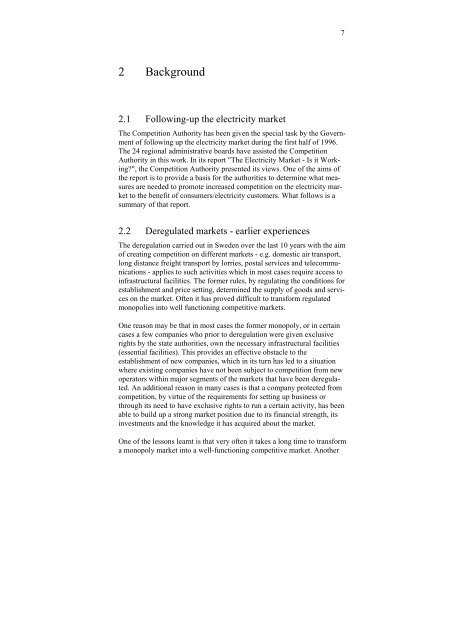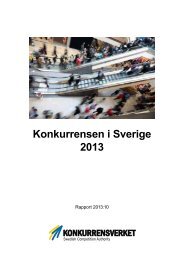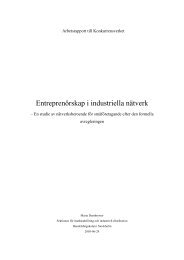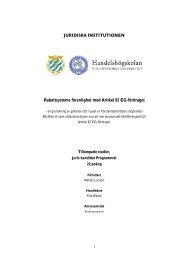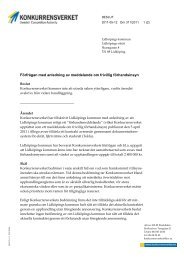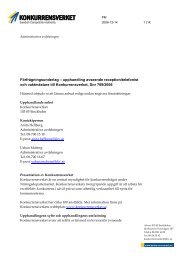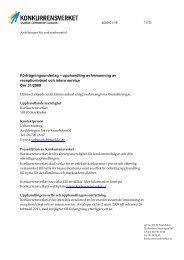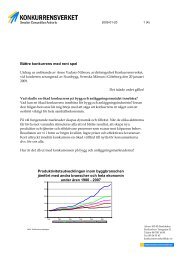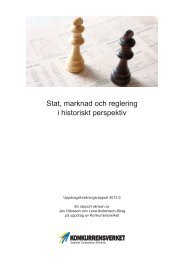Report 1996:3, Deregulation of the Swedish Electricity Market
Report 1996:3, Deregulation of the Swedish Electricity Market
Report 1996:3, Deregulation of the Swedish Electricity Market
Create successful ePaper yourself
Turn your PDF publications into a flip-book with our unique Google optimized e-Paper software.
2 Background<br />
2.1 Following-up <strong>the</strong> electricity market<br />
The Competition Authority has been given <strong>the</strong> special task by <strong>the</strong> Government<br />
<strong>of</strong> following up <strong>the</strong> electricity market during <strong>the</strong> first half <strong>of</strong> <strong>1996</strong>.<br />
The 24 regional administrative boards have assisted <strong>the</strong> Competition<br />
Authority in this work. In its report "The <strong>Electricity</strong> <strong>Market</strong> - Is it Working?",<br />
<strong>the</strong> Competition Authority presented its views. One <strong>of</strong> <strong>the</strong> aims <strong>of</strong><br />
<strong>the</strong> report is to provide a basis for <strong>the</strong> authorities to determine what measures<br />
are needed to promote increased competition on <strong>the</strong> electricity market<br />
to <strong>the</strong> benefit <strong>of</strong> consumers/electricity customers. What follows is a<br />
summary <strong>of</strong> that report.<br />
2.2 Deregulated markets - earlier experiences<br />
The deregulation carried out in Sweden over <strong>the</strong> last 10 years with <strong>the</strong> aim<br />
<strong>of</strong> creating competition on different markets - e.g. domestic air transport,<br />
long distance freight transport by lorries, postal services and telecommunications<br />
- applies to such activities which in most cases require access to<br />
infrastructural facilities. The former rules, by regulating <strong>the</strong> conditions for<br />
establishment and price setting, determined <strong>the</strong> supply <strong>of</strong> goods and services<br />
on <strong>the</strong> market. Often it has proved difficult to transform regulated<br />
monopolies into well functioning competitive markets.<br />
One reason may be that in most cases <strong>the</strong> former monopoly, or in certain<br />
cases a few companies who prior to deregulation were given exclusive<br />
rights by <strong>the</strong> state authorities, own <strong>the</strong> necessary infrastructural facilities<br />
(essential facilities). This provides an effective obstacle to <strong>the</strong><br />
establishment <strong>of</strong> new companies, which in its turn has led to a situation<br />
where existing companies have not been subject to competition from new<br />
operators within major segments <strong>of</strong> <strong>the</strong> markets that have been deregulated.<br />
An additional reason in many cases is that a company protected from<br />
competition, by virtue <strong>of</strong> <strong>the</strong> requirements for setting up business or<br />
through its need to have exclusive rights to run a certain activity, has been<br />
able to build up a strong market position due to its financial strength, its<br />
investments and <strong>the</strong> knowledge it has acquired about <strong>the</strong> market.<br />
One <strong>of</strong> <strong>the</strong> lessons learnt is that very <strong>of</strong>ten it takes a long time to transform<br />
a monopoly market into a well-functioning competitive market. Ano<strong>the</strong>r<br />
7


